by Winding Pathways | Apr 17, 2025 | Geology/Weather, Nature, Travel/Columns
Quincy Warmth
After a short walk through deep snow in the bitter cold, we entered a dimly lit tunnel. As we stepped into Quincy Mine’s long tunnel we were surrounded by warmth. Well, the warmth was relative. Outside it was below zero but inside the tunnel was a balmy 43 degrees.
We visited Quincy Mine in Michigan’s Keweenaw Peninsula in frigid February, but if we had been there on a blistering hot August day the mine’s interior temperature would be a delightfully cool 43 degrees. It’s always that temperature in that tunnel deep underground.
No matter the season, the Keweenaw Peninsula is a fun place to visit. It juts upward into Lake Superior. Lake effect snow piles deeply each winter, but in summer the Lake sends cool breezes inland.
“We Do Winter Well”
This claim by Visit Keweenaw advocates is no exaggeration. Residents navigate steep, snowy streets with aplomb. Some travel by snowmobiles to work, take a short spin during lunch breaks, and motor on home after work. They dress warmly and relish the cold. The area welcomes winter visitors who enjoy downhill and cross-country skiing, snowshoeing, snowmobiling, shopping, and meals of grilled lake whitefish and locally made pasties. More about them later. Broom and ice hockey regionally and at the Michigan Technological University draw in families by the dozens. The Huskies, sometimes known as the “Stick Huskies” – think hockey – compete, creating fabulous ice sculptures that dot the campus and area.
-

-
Trail groomers started before dawn to groom trils.
-

-
ice sculptures dot the town and campus.
-

-
BoHo is an ungroomed Black Diamond ski area.
Shopping and dining are equally fun in summer, and warmer weather offers boating, swimming, fishing, and sightseeing. During warm months, visitors can book a ride on boats taking them to the distant Isle Royale National Park.
What and Where Is the Keweenaw?
The Keweenaw is actually a peninsula on a peninsula. It’s attached to the relatively wild Upper Peninsula, but interestingly it’s no longer a peninsula at all. Originally a natural inlet extended most of the way across the peninsula’s base. To facilitate shipping, land was removed, extending the inlet into a canal and making the Keweenaw an island. Today the main towns of Houghton and Hancock face each other across the Portage Canal and are separated by one of the world’s largest lift bridges. In summer, dozens of boats motor by, including some large ones.
Copper Country
For us touring Quincy Mine was a visit highlight. For nearly a century it produced thousands of tons of copper that helped America electrify. Quincy is only one of several that once operated in the area but they all were abandoned when less expensive, open pit mining got established in Utah.
Today Quincy Mine welcomes people to tour its towering surface features that pulled ore up from upwards of 9,000 feet underground. Down that far, the temperatures were blistering 80+ degrees. It was amazing, but we were more fascinated deep down in a mine tunnel when our guide, Clayton Gomez, stopped our small group and doused the electric lights, leaving only one candle to illuminate the vast darkness. “This is how much light miners had as they used muscles to drill into the rock.”
“They’d then stuff blasting power into the hole and set it off. Afterward they loaded the loose stone in carts and pushed it to a shaft where a lift carried it to the surface. It was dangerous and hard work. They earned $2 for a 10-hour shift,” he added. Some of us tried to muscle the heavy cart to little avail.
Initially, the demand was for highly skilled workers in teams of three. One held an iron bar, two alternated hitting the end. In between the one holding the bar, turned it slightly so it would not lodge in the rock. At best this would be dangerous. Done by candle light, required cooperation and skills. Mining innovations changed that. Men worked alone so if an accident happened, they might not be found for hours.
Clayton ended our tour with this thought: “Holes in the ground all we have left to tell the story.” But, he pointed out, copper remains such an important part of our lives. Computers, cars, cell phones.
-

-
Clayton and mine shaft diagram.
-

-
Mine shaft drum.
-

-
Canal. Park Service Boat. Ski run. Quincy Mine Shaft on far hill.
Who Were the Early Settlers and Miners?
The workers, immigrants from the Cornish region, were small, tough, wiry. In the paternalist setting where they received housing and a few amenities, if one got injured or killed, the family was forced to move. After a sweat-soaking shift, the men would change into clothes and step into the sub-freezing weather and trundle home. Only to repeat the process the next day.
Other immigrants from northern Europe arrived and took to the cold, snowy climate. Today skiing and ski jumping are hallmarks of the Nordic heritage. Evidence of the Daughters of Italy, Sons of Norway, Canadian, Finnish and Cornish ancestry highlight the area.
Although mining is now long gone, a delicious traditional food remains. A meat and vegetable pie called a pasty is tasty, nutritious, and portable. (Say the word with a short “a” so as not to confuse with an accoutrement of pole dancers.) Miners would bring this traditional Cornish meal with them as they descended into the pit and enjoy it for lunch.
Many local stores and cafes now sell pasties and we ate several during our stay.
We also enjoyed taking a sauna at Takka Saunas on a frigid day. After sitting in a steamy small sauna building, we dashed out. Marion did the traditional Finnish tradition of laying down in the snow making a snow angel. Rich only stood barefoot in the snow. A sauna part of Finnish culture is fun in any season.
-

-
Amenities abound
-

-
Roll in the snow or plunge into cold water.
Keweenaw Mountain Lodge

Dark sky and slow travel haven.
Part of our adventure was finding respite at the Keweenaw Mountain Lodge. Some in our group snowshoed. Others lounged in the rustic ambiance. Adjusting to “slow travel” and learning more about the dark sky options. As the lodge owner stated, “We lean into what is authentic and unique.” Heated cabins and groomed trails beckoned. The chef creates delicious picnic baskets and the Tasting Post features a “slow dining” experience. On clear nights the aurora is spectacular.
Jibba Jabba
We went to the Keweenaw for the annual Jibba Jabba Railjam. Dozens of young competitors climbed the manufactured hill in downtown Houghton and took turns sluicing down the steep slope, riding rails, swooshing through the tunnel, and spinning to a stop in front of hundreds of enthusiastic spectators. For days ahead, city crews had hauled in and packed snow at just the right angle on one of the steep streets that are hallmarks of Houghton. The result? Fast speed and thrilling rides down the course.
-

-
Snowy wait
-

-
Excitement
-

-
Snowy event
Getting There
Five hundred miles north and slightly East is the thumb of the Keweenaw that juts into Lake Superior. Houghton, MI, is Eastern time so we lost an hour. We took two days going, stopping to walk a special labyrinth in Westfield, WI, and overnight at Rhinelander, taking in the Hodag Hunt. These mythological creatures frequent the town and purportedly the nearby forests. We did encounter several in town, which was fun. Eagle River is worth a stop with a terrific coffee shop and amazing annual ice sculptures.
-

-
The Labyrinth we built as Andy’s Memorial.
-

-
Special labyrinth
After two hours of snowy and scary driving we found clear pavement. Good thing we have advances in car technology and road safety. We stayed on our side of the road because of the center and side rumble strips. No “good ‘ole days” for us. We prefer safe cars and roadways.
We drove back in an easy day as we gained an hour.
-

-
Welcome!
-

-
Hodag hunt
-
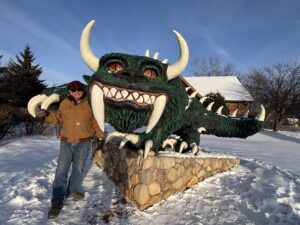
-
A beaten path to the visitor center Hodag.
For information on what to do at the Keweenaw and where to stay check out Visit Keweenaw.
We were there during winter’s icy grip but a future visit during summer’s warmth is in our plans.
by Winding Pathways | Dec 19, 2024 | Geology/Weather, Nature

Frosted glass!
The world around Winding Pathways changed overnight. On December 14, 2024, we awoke to an ice-glazed world. We know that hurricanes, tornadoes, and derechos cause widespread havoc. Ice storms present their own perils to trees, people, and wild and domestic animals.
After lighting our woodstove, we pulled traction devices on our boots, grabbed trekking poles, and ventured outside just long enough to check for damage, gather eggs, and fill bird feeders.
Checking for Damage
Ice crystals sparkled and ice sheets reflected morning’s light in unusual ways as we carefully picked our way around the yard. Fortunately, we found no downed tree limbs and our chickens were tucked safely inside their coop. Wild birds had no choice. We filled all our feeders, sprinkled seeds on the ground, and scattered sand. Some we tossed on walkways to provide traction for us and a few scoops went amid the birdseed under our feeder. Birds need grit for digestion and it’s hard to find when the world is icy.
Helping the Birds
Many winter birds feed on frozen insects and spiders tucked into the crevices of tree bark. Others scratch through leaves to find seeds and bugs. With trees and the ground sheeted in ice, pickings were slim for animals that must eat an enormous amount of food daily to maintain a body heat of around 106 degrees.
It’s no wonder that cardinals, juncos, nuthatches, blue jays, chickadees, and the five species of woodpeckers in Iowa crowded our feeder and the ground underneath it on that icy morning. Starlings and house (English) sparrows soon showed up.
The overnight ice storm was not so thick that the tiny birds got trapped under the flap of bark where they often rest in storms. They were able to break out and get to the feeder before other birds arrived.
-
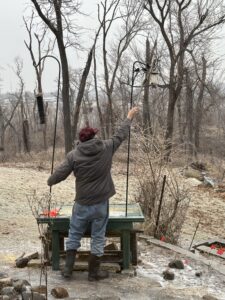
-
Ice was so thick Rich hit with a pole to loosen it.
-

-
Birds came early.
Turkeys Arrive

Wind ruffling back feathers.
We wondered when the gang of turkeys would show up and whether they weathered the night in the tops of the swaying and ice-encrusted trees. Late morning “Louie the Lonely Turkey” carefully picked his way across the frozen grass. What a surprise when he hopped up on the top of the sheet of ice on the platform feeder! He shot off the other end and, doing a pirouette like Sam Gribley in My Side of the Mountain, thumped down quite flummoxed when he stepped onto the ice after an ice storm. Louie gingerly climbed back up onto the platform feeder. And, we had our answer as to where he had slept. One side of his feathers and beard were crusted with ice. He had endured a cold night swaying in the tops of the tree as usual. The others haven’t shown up yet, so Louie feasted on the corn and sunflower seeds.
Deer Stayed Put
One backyard animal was initially absent. Often deer visit at night or early each morning but the icy glaze covers their food and makes walking treacherous. Unlike birds, deer put in a thick layer of fat each fall. During storms, they find a sheltered spot and “hole up”. They can sit still for several days without feeding to ride out a storm. A few did finally show up, realized the table goodies were again covered with ice from the day’s rain turned to ice, and left discouraged.
Squirrels Tried to Forage
Squirrels didn’t fare too well foraging and seemed to hole up in their tree holes or nests made of clumps of leaves in the tree tops. The previous night must have been quite the ride for them as well as the turkeys with the trees swaying and ice cracking on limbs.
Prairie Grasses Haven for Small Animals In Ice Storms
The prairie grasses on the knoll bent over with ice formed small enclosures where our resident cottontail took refuge. Deer tracks crossed the Harmony Phoenix Labyrinth as they wandered in the night.
-

-
Contrast in color and texture.
-

-
Birches bending under the weight. of the ice storms
Robert Frost had it right in his poem, Birches, “When I see birches bend to left and right, Across the lines of straighter darker trees, I like to think some boy’s been swinging them. But swinging doesn’t bend them down to stay. As ice storms do.”
The ice will melt as temperatures rise. Until it does, we’ll walk cautiously to reduce the odds of falling and keep our feeders well-stocked with seeds and grit.
by Winding Pathways | Aug 31, 2023 | Geology/Weather, Travel/Columns, Trees/Shrubs
Travels this summer showed how varied the North American continent’s vegetation, landscape, and weather are. Most recently we have journeyed from New Jersey to Southern Saskatchewan. Vegetation and terrain could not be more different.
Venturing from “Wide Open Spaces” to “Into the Woods”
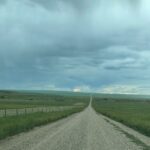
Native forbs and grasses cover the land.
The Dixie Girls’ refrain “Wide Open Spaces” describes the terrain we drove through in Southern Saskatchewan. One day Rich hiked to a high spot in Grasslands National Park. Beneath and beyond him were thousands of acres of grasslands – forbs and native grasses. Nary a tree poked upward in this vast and beautiful land.

Brook waters tumble over rocks.
In contrast “Into the Woods” by Sondheim and Lapine would better characterize the roadside woods as our car approached New Jersey six weeks later. Jersey’s woods are so dense and thick that little sunlight filters through the leafy crown. On wood edges, impenetrable tangles of shrubs, brambles and vines seem to be everywhere.
Goldilocks Zone

Iowa’s woodlands tend to be more open than eastern woods.
True to its location in “middle America,” our home in Eastern Iowa fits somewhere in between. You might say it is the “Goldilocks Zone” of vegetation. Midwestern woods tend to be more open than New Jersey’s but dense compared with Saskatchewan’s few low brushy areas. Iowa’s neither wide open nor dense but somewhere in between. It’s like a hybrid.
Location, Location, Location
What makes such a striking difference in vegetation extremes? These numbers tell part of the story:
Location Annual Precipitation Annual Mean Temp Wind
Saskatchewan 14” 39 F often and strong
New Jersey 54” 48 F calm to light
Iowa ranges in the middle with an average of 36” of precipitation.
Numbers don’t tell it all. New Jersey’s climate is moderated by the ocean, so the hottest temperature ever recorded near Rich’s hometown of Denville was 104 degrees Fahrenheit, and the coldest was -21. That’s a 125-degree variance. In Val Marie, Saskatchewan, the highest temperature ever recorded was 113 degrees Fahrenheit, and the lowest was -70. That’s a whopping 183-degree variance.
When we visited Val Marie, Saskatchewan, on the summer solstice, the sun was brilliant, the breezes gentle, and the night air cool. Sunsets lingered and the moon seemed to pop over the horizon and grace the landscape all night. Recently, thick smoke from wildfires blanketed the province like it has in Iowa and temperatures soared.
We hit New Jersey just right with warm day temperatures, a slight south breeze, tolerable humidity, and evenings that cooled down. The wildfire smoke had moved out. We were fortunate both times.
There’s more
Saskatchewan is much further north than New Jersey, so it receives significantly more summer light and much less sunlight in winter. Generally, Saskatchewan enjoys low humidity, while Jersey sweats in humid air year-round.
These differences in light and temperature plus topography, soil type, and the way people manage the landform its appearance and determine what species of plants and wildlife can exist there.
We noticed that people who live in the thickly wooded East are sometimes uncomfortable when traveling in the West’s wide-open spaces and Westerners feel claustrophobic amid the thick growth in the East. Comfort levels vary with the terrain.
Commonality
Both Saskatchewan and New Jersey do share a common feature. Rocks! Everywhere are pebbles, rocks, and boulders. Saskatchewan was glaciated and rocks, carried in by sheets of ice, litter the fields. Piles dot the fields where ranchers and farmers have piled them so they can till the sandy-type soil. New Jersey’s rocks are often bedrock with glacial striations and miles of rock and stone walls.
-

-
Lichen-covered boulders
-

-
New Jersey’s inland landscape is defined by boulders.
What’s the difference between a rock wall and a stone wall? Well, there really isn’t. Both are made of rocks. But some, like rounded glacial rocks, were hauled from fields and tossed into rows to make boundaries. It takes a lot of work to maintain them. As Robert Frost stated in one poem, “Good fences make good neighbors.”
Others, flatter rocks like slate and shale, are easier to fit together. Marion’s dad was a stone worker crafting rock walls, carefully choosing rocks to fit well together. These rock walls stand for decades. At any rate, both Saskatchewan and New Jersey have an abundance of rocks that influence how land is used.
One of our traveling pleasures is noting vegetation and topography through our car’s windows, even as we speed along. To us, all places are interesting, and no matter what the terrain and vegetation we’re passing through it’s fascinating.
by Winding Pathways | Mar 9, 2023 | Foraging, Geology/Weather, Maple Syruping

A slice of history.
Scars in a tree at the Indian Creek Nature Center reveal maple syruping history.
Back in 1979 Rich Patterson and volunteers approached a husky Box Elder tree, armed with a drill, spile, and buckets. It was early March. Nights were cold and frosty, followed by warm sunny days. Syrupin’ weather.
Oozing Out the Sap
As soon as the drill’s bit cut through the tree’s bark, clear watery sap oozed out.
Rich gently tapped in a metal spile and hung a bucket under it. By day’s end, two gallons of clear sap nearly filled the pail ready to be boiled into syrup.
-

-
The spile angles slightly downward.
-
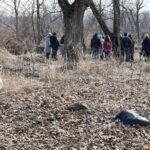
-
Visitors and plastic bag on tree
If not overdone tapping just harvests a small percentage of a tree’s sap. It’s sort of like a person giving blood. Taking a little does no harm. Healthy trees quickly create a scab over the tap hole, somewhat like a human body heals a scratch. As the tree grows and its trunk diameter swells, wood forms over the old tap hole. It’s fine to tap that tree again next year, the year after, and every following year.
Syruping season ends when night temperatures don’t drop below freezing. That’s when spiles are pulled, leaving the hole for the tree to heal.
Aging Out of Production
That’s what happened to the Nature Center’s tree. Box Elders are true maples capable of producing sap for quality syrup, but they are short-lived. An 80-year-old Box Elder is, well, elder and near life’s end. After being tapped for 40 years in a row the Nature Center’s box elder reached the end of its days converting solar energy into sugar. After its death staff felled it, revealing at least 30 tap scars. The oldest ones are closest to the center of the tree’s trunk.
Syruping is a fun late winter activity. To learn more visit the Indian Creek Nature Center during syruping season. It holds a fun Maple Syrup Festival in late March each year. For details check out Indian Creek Nature Center’s website.
Thanks, box elder for sharing some of your sap all these years.
-

-
Tasting sap from a sumac spile
-

-
Syrupin’ time is upon us!
by Marion Patterson | Jun 2, 2022 | Chickens, Garden/Yard, Geology/Weather, Hoover's Hatchery, Preparedness, Reflections/Profiles, Travel/Columns
Coming up to a year from the last post on the features we wrote for the Cedar Rapids Gazette, here is an updated list for the second half of 2021 and the first half (almost) of 2022. These features are in addition to our regular work with Hoover’s Hatchery blogs and FB Live and our own blogs for Winding Pathways.
May 8, 2022. Splish Splash! Whitewater Kayaking in Iowa. (No link to date)
April 22, 2022. Finding America On Roadways East.
April 13, 2022. Muscle Over motor When Boating.
March 21, 2022. Rockhounding.
January 30, 2022. Backpacking Bonus. (8B of GZ. No link to date) Available Green Gazette.
January 24, 2022. Distinctive Religious Structures.
January 16, 2022. Hiking Wild Areas. (no link to date) Available Green Gazette.
December, 2021. Country Schools. (no link to date) Available Green Gazette
November 15, 2021. Making a (Mini) Pitch for Soccer.
October 6, 2021. A visit with Midwest’s Pioneering Authors.
September 8, 2021. Taking a Slow Boat to Cassville.
September 6, 2021. Camping in Iowa’s Trout Country & Decorah’s Celebrities.
August 4, 2021. Parking While Headed East. And Solar Panels at Peoples.
by Winding Pathways | Feb 17, 2022 | (Sub)Urban Homesteading, Geology/Weather, Reflections/Profiles
New England’s Nor’easter January 29-20, 2022
by Susan Fellows, guest blogger
What is a Nor-easter?
Dover, NH, 4:00 a.m. Temperature 5 degrees. The wind chill is probably close to -10 degrees. Wind gusts 40-45 mph throughout the day. What is a blizzard? Wind gusts more than 35 mph. Snow blowing and drifting. Visibility less than 1/4 mile. All more than three hours. We grew up with blizzards, know them well, and call them Nor’easters.
The description above is what I saw outside my living room window all day on January 29, 2022, in excess of eight hours. There is a large green space next to my apartment building with a stand of pine trees at the far end, where there is no snow. An area just outside my apartment going out about 20-30 feet where the wind blew the snow off all day long made it look like we had only a dusting of snow. Beyond that, snow accumulated up to 1″-2″ per hour for several hours. Most of the day, I could not see the trees which are less than a 1/4 mile away.
-

-
Strong winds swept some areas bare of snow.
-
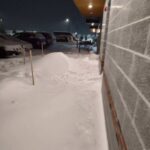
-
The building blocked the wind.
Following the Progress of the Storm
The well-predicted storm made its way up the coast from South Carolina, past Washington, DC, Philadelphia, and New York to New England. Snowfall reported in Bridgewater, MA, totaled 32″! Out at Wellfleet on the south side of Cape Cod, wind gusts reached 82 mph. Fortunately, in Dover, NH, we weren’t hit with as much snow and wind gusts were in the 40 mph range. Most of the day and into the evening I watched snow blowing horizontally past the windows. Whiteout! An all-day blizzard.
Venturing Out
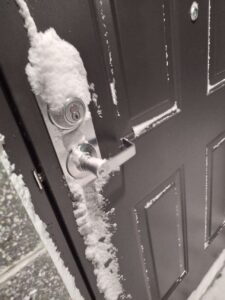
Opening the door was difficult
7:30 p.m. I decided to get my mail if there was any. True to the USPO motto, through rain, wind, snow, and dark of night the Post Office did deliver the mail! Getting out my door was difficult as the snow had accumulated to about three feet. So, it was hard to open the door. Along the sidewall of the building I trudged. Not as much snow there. But, once I reached the lobby door, I had to get to the security post to swipe my key fob to open that door. Snow spilled into my boots and I had to shove the door open about a foot to squeeze through. After picking up my mail, I made my way back to my apartment.
Manager & Snow Crews Respond to Safety Concern
The snowfall seemed to be easing up but it was hard to tell as the wind still picked up and carried snow horizontally past my window. Remembering that some Eastern big cities had had fires in apartments recently, I was concerned with conditions by the exit doors. So, I called the answering service of the apartment complex. Shortly our maintenance supervisor returned my call. I explained the situation and my concern that in case of an emergency requiring evacuation of the building the other residents might not be able to get safely out. He replied that the snow removal team would return the next morning. After some discussion, with the supervisor being unrelenting with his statement that the team would be back in the morning, I simply asked who would be liable if an evacuation were needed and people could not safely get out. Then, I hung up.
Soon after the property manager called, respected the fact that I was observing the conditions and he wasn’t. He called the supervisor of the snow removal team. Within the hour they arrived! I was relieved!
Blindingly Beautiful
Sunday, January 30, 2022. The day dawned bright and beautiful! What a change from not being able to see because of the blizzard! People were out with their pets and children enjoying the light, fluffy snow. The snow removal team cleared the overflow lots and residents moved their cars so the parking log could be properly cleared. Gigantic piles of snow were all over the place and sidewalks, doorways, and cars cleared of the eight inches of reported snow. One town, right on the ocean about 12 miles away, got the state’s grand total of 13.5″. The wind, she kept on blowing and the temperatures were bitterly, brutally cold.
-

-
People moved their cars to help with snow removal.
-

-
The doorways are cleared of snow.
-

-
The snow removal team quickly cleared snow.
The next day, in appreciation, I called the supervisor to thank the crews for coming out in the storm and making sure residents were safe.
Prior to the storm, everyone had been told to stay off the roads, which they did. All-day Saturday, I had watched a storm tracker show from a Boston station. Indeed except for plows and utility crews restoring power, the roadways were clear of vehicles.
I LOVE SNOW and this was quite an event!







































